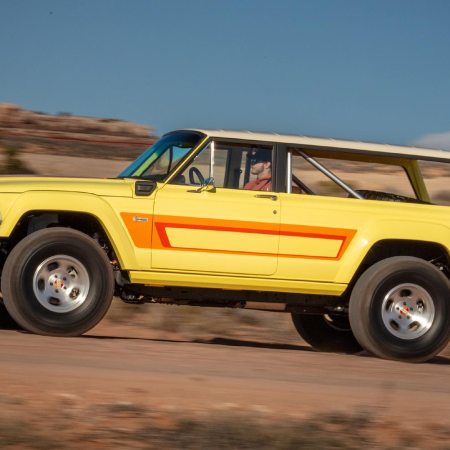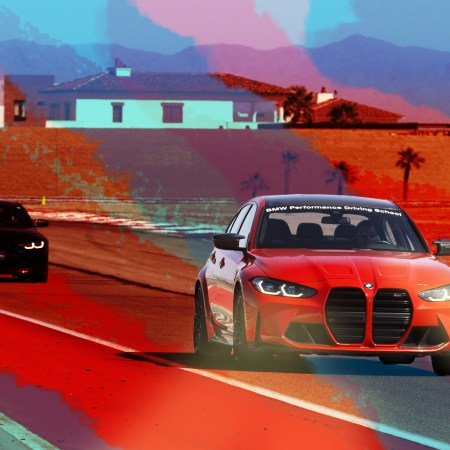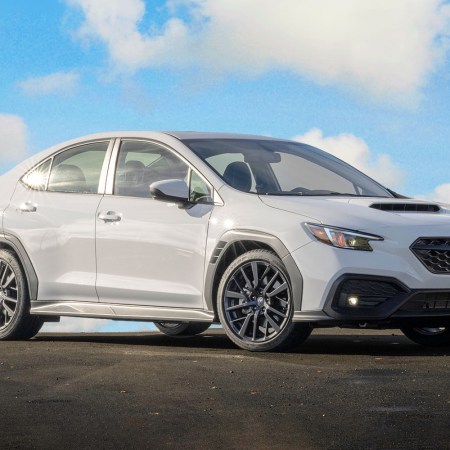For some people, rejuvenation comes in the form of a golf weekend with friends. For others, it’s heading back to college campus for a football game. Still others seek out breweries looking for the perfect pint. Then there is that group of people, smaller in number but no less passionate, for whom the apex of experience is hopping behind the wheel of a vintage automobile and testing one’s car and capability against the rigors of the open road. I fall into the latter category, and I recently had the good fortune to participate in the Fuelfed Motorgearo 250, the Midwest’s premier classic European car enthusiast driving event.
Let me tap the brakes a moment, because there’s a lot packed into that sentence. Fuelfed, for starters, is a private classic car club based on the North Shore of Chicago. (There are now branches in several states — see below for more info.) Classic, as the club defines it, means cars of a vintage 1995 or earlier. The Motorgearo is an annual driving event unique to the club — it’s not a race nor a competitive rally (like a time-speed-distance or game event), but a multi-stage drive in which participants cover 250 miles a day through a curated path of winding backroads, sweeping curves, and undulating elevations. It’s not about speed or winning. It’s about being out on the open road with your friends in cars that would have long since disappeared back to the elements were it not for the care, passion, and talent of their owners.
It’s worth spending a moment to explain how I got here — and how you might find yourself with your feet in the same exhilarating wheel well. I grew up around cars. Alfa Romeos, to be precise. My dad was an avid restorer of the marque and I was his garage assistant and co-pilot on trips to racing weekends as a kid. Fast forward 30 years and I’d pretty much buried the memories until I saw a poster for Fuelfed in my hometown of Glencoe, Illinois. The brightly colored vision of vintage steel reignited my interest and got the pistons moving in my mind.
You can’t join a classic car club without a car, so I immediately started searching online for a good starter model. I didn’t have unlimited funds, so it needed to be affordable with easy-to-acquire parts, relative reliability, and a strong community of drivers to meet and learn from. When I’m inspired I move pretty fast, and within a month I found myself behind the wheel of a white-on-black 1976 Triumph TR6 from a vintage dealer near my home.
With my car acquired and club membership obtained, it was time to drive.
The founder of this orchestra of rolling steel is Brian Hughes. He started Fuelfed in 1998, and he runs it with his wife, Lorraine. To say they do it right is like saying Phil Hill was a pretty good driver. The club exists to foster bonds between drivers who share a love of vintage automobiles. There are frequent meet-ups for coffee, impromptu drives, swap meets for car parts and memorabilia, and other get-togethers designed to build community. Their events are meticulously planned, and this is certainly true for the MG250. Roads are scouted months in advance and then re-checked multiple times, lodging and restaurants carefully selected for their charm and quality, drive books and maps are impeccable, and the whole long weekend has the cadence of a perfectly executed ballet of iron and oil. On top of the flawless execution, they are extraordinary hosts, somehow making sure everything runs and still having time to chat and catch up with every driver. It feels like family.
“I wanted to create a Midwest rally that was on par with the big rallies, celebrated small towns, and was affordable to a wider variety of European classics and people, without the sales pitches,” says Hughes. “I wanted it to be grass roots and home grown, not overseen by a corporation. Quality local establishments and bespoke experiences are always important to the MotorGearo.”
Judging by the level of participation and enthusiasm displayed by the participants, it seems like he hit the mark.
“I’m in several car clubs, and what I love about Fuelfed is all the driving events,” says Alan Blum, who is running this year in his black 1991 Ferrari 348 ts. “A lot of clubs are about driving to lunch, or maybe a museum. In Fuelfed the point is to use the cars.”
Use them we did.
This year, the MG250 featured 40 European classic cars covering 500 miles of country roads in two days. Each Motorgearo is different, but this one started in Dubuque, Iowa. We drove through a couple of other states from there, but the details of the route are guarded because so much time goes into the planning that it’s a bit like a secret formula. As for Dubuque, it’s a gem sitting right on the banks of the Mississippi River dotted with cathedrals, bell towers, and elegant homes standing sentry on imposing bluffs. It was the perfect setting for our roaring commencement.

After the morning driver’s meeting, we jumped into our seats and started our engines. As for the cars, the MG250 is a rolling museum. British, Italian, German, Swedish classics are represented – from a 1962 Jaguar E Type OTS to a 1969 Alfa Giulia Super to a 1990 Porsche 911 Outlaw to an impeccable 1972 Volvo 142e. As we rumbled into our four run groups, the sound of our engines reverberated off the old brick walls of the warehouse canyon like a thunderous symphony. Curious onlookers streamed out of buildings to wave, snap photos, and take it all in. This same ritual took place throughout the weekend. As we drove through small towns nestled amid farms, families stood on their lawns and waved or walked up to us at gas stations with giant smiles across their faces. It struck me that there is something about the automobile that inspires people, even in the era of personal spaceflight and quantum computing. There seems to be an intrinsic awareness upon the sight and sound of an old car that years ago resourceful humans applied flame to fuel, encased explosions in iron, and somehow made something move — very fast. When you’re driving for hours, serenaded only by your engine and the wind, you think about these things.

For the next two days, the MG250 took us through a living and breathing postcard of middle America. The roads wove through rolling green hills and past imposing rock formations that hinted at less forgiving earth beneath the flowering fields. As I stared out the side window at brisk speed, the rows of crops flitted like a scene from a Zoetrope. Since I have a convertible, the skies provided another vista. I saw hawks flying with their young against an endless blue canvas and noticed the position of the sun changing over the course of the day. And then there were the curiosities that you pick up when you’re not staring at a phone or bombarded with the endless chatter of the news cycle. A young kid on a minibike was tearing around his yard. A small family-size church sat at the end of a driveway, apparently built for convenient worship. Turtles crossed the road. One of our drivers stopped our group to help them safely along. This is the spirit of Fuelfed. The drivers look out for each other. We have become friends, we know each other’s cars, but we also know each other. Sons drive with their fathers. Husbands and wives drive together. Brothers and fathers and daughters navigate the roads as teams. At our lunches and dinners, and later at the bar, friends share tales from the day and talk about how a fuel leak was corrected or a broken overdrive was circumvented to enable the crew to motor on and finish the route.

One of the most amazing things that occurs on the Motorgearo is what happens to one’s perception of time. In the absence of context, the thought of driving backcountry roads for two days straight could seem arduous or perhaps even chore-like. (I can’t even listen to my radio because it’s so old and lacking in power that all I can hear is high frequencies, all cymbals and screaming.) But when you’re settled in, running through your gears, and focused like a laser on the road, the day flies by like the dashes on a ribbon of asphalt. After the first four stages, I could have easily done two more.
At the conclusion of our second day, when we finally pulled into the last hotel after logging all 500 miles, the sense of accomplishment was palpable. As our dirty cars finally rested and cooled down, the drivers headed to the bar for a celebratory toast and hors d’oeuvres. As they are wont to do, Brian and Lorraine hosted a traditional Wisconsin dinner and lighthearted awards ceremony. As the night went on, conversations shifted from fuel injectors and manifold coatings to careers and kids’ college choices. Often there is a surprise guest. This time it was automotive legend Chris Beebe, who popped in to join the dinner. Like the other Fuelfed members, he was gracious, kind and eager to share his knowledge. It was clear looking around that the reason this club is so great is that it can accommodate all of this. The hobbyists like me, and the lifers like Chris. The road is our common ground.
Later that night, lying in bed, I could feel the ache in my arms from all the steering and my ears were ringing from 10 hours of listening to the dual exhausts wailing. The Motorgearo had left an impression. You could literally feel the drive. You won’t get this from a modern car. This sense of connection — a connection to the road and to your fellow drivers, one and the same.
How to Get Started
If you’re fortunate enough to live in Chicagoland, southeastern Wisconsin, western Michigan, Fort Lauderdale, or Boulder, you will be in the vicinity of a local Fuelfed (www.fuelfed.com) chapter. Their morning Coffee & Classics events are good places to talk to owners and start figuring out which models and makes you like and get advice about where to service and purchase cars. Fuelfed chapter or not, a great first step is to attend local automotive events. See different cars. Ask lots of questions. You’ll find that classic car owners are a gregarious and warm group, eager to share what they know and to help steer you in the right direction. Personally, I liked buying from a classic car dealer because it also had a shop with mechanics who know the cars. But plenty of people buy from private owners. Be sure you bring along an expert if you aren’t one yourself. The clubs are also a great way to learn who’s selling or where cars might be for sale. Learning as you go is part of the fun. One last bit of advice is to go into this experience with your eyes open. Even the most reliable vintage car is not going to be … reliable. The sooner you come to terms with this notion, the happier your drives are going to be. Try as you might, you won’t tame mechanicals that are half a century old. But given the chance, those old mechnicals will take you places you never dreamed possible.
This article was featured in the InsideHook newsletter. Sign up now.






















